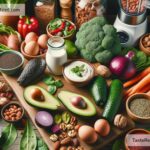Title: Foods That Boost Your Nutrition Education
Learning about nutrition is like discovering the blueprint for a healthy and happy life. Understanding what foods do for your body helps you make smarter choices and inspires you to enjoy healthier meals. But where do you begin? Let’s dive into the basics of nutrition-rich foods and how they can enhance your knowledge—while also improving your health.
Why is Nutrition Education Important?
Nutrition education is the process of learning how foods affect your body and overall well-being. It helps you understand which nutrients your body needs to grow, stay active, and fight sickness. By learning what types of foods provide certain nutrients, you can make better decisions when shopping for groceries, cooking meals, or eating at restaurants.
Foods That Teach You About Nutrition
The great thing about food is that it can be both delicious and educational! Let’s explore some common foods that are not only nutritious but also offer key lessons about the nutrients your body craves. Pay attention—these can help you become a nutrition expert!
1. Fruits: Nature’s Sweet Treat
Fruits are packed with vitamins, minerals, fiber, and antioxidants. They are the perfect example of “nutrient-dense” foods, meaning they contain a ton of good stuff in just a small amount.
Essential nutrients in fruits:
– Vitamin C helps your immune system and makes your skin glow.
– Fiber keeps your digestive system healthy.
Examples:
– Oranges, lemons, and strawberries teach us about Vitamin C.
– Apples, pears, and bananas remind us to eat fiber for digestion.
Takeaway Message: Eating a variety of fruits introduces your body to different vitamins, teaching you how each one plays a role in your health.
2. Veggies: Green Powerhouses
Vegetables are the unsung heroes of nutrition! They provide essential vitamins, minerals, and fiber, just like fruits, but with fewer calories. Vegetables come in all kinds of colors, and each one has unique nutrients.
Examples:
– Spinach and kale are high in iron, which helps your blood carry oxygen.
– Carrots and sweet potatoes are rich in beta-carotene, which keeps your eyes healthy.
Takeaway Message: Think of your plate as a rainbow—eating colorful vegetables means you’re learning about antioxidant protection and improving multiple areas of your health.
3. Whole Grains: Energy Builders
Whole grains, like brown rice, oatmeal, and quinoa, are packed with long-lasting energy because they contain complex carbohydrates. Unlike processed grains, whole grains also have fiber and B vitamins.
Key nutrients in whole grains:
– Fiber helps control blood sugar levels and keeps you full longer.
– B vitamins give your body energy and support your brain function.
Examples:
– Swapping white bread for whole-grain bread introduces a lesson in how fiber helps digestion.
– Eating oatmeal for breakfast shows how slow-burning carbs improve focus and energy levels all day.
Takeaway Message: Whole grains teach you the importance of choosing energy-providing foods that fuel your brain and body.
4. Proteins: Body Builders
Proteins are like the construction workers of your body—they repair and build muscles, skin, and other tissues. Learning about protein-rich foods helps you understand how your body stays strong and functions properly.
Examples:
– Chicken, fish, and eggs supply lean protein that’s great for your muscles.
– Beans, lentils, and tofu teach us about plant-based proteins that are good for the heart.
Takeaway Message: Incorporating different protein sources encourages balance, helping you see how meat and plant-based options complement each other.
5. Dairy and Dairy Alternatives: Calcium Boosters
Dairy foods like milk, cheese, and yogurt are known for being rich in calcium and vitamin D, which strengthen bones and teeth. If you’re lactose intolerant or vegan, you can still learn the same lesson with dairy alternatives like almond milk or soy yogurt.
Examples:
– Regular milk introduces the concept of calcium for bone health.
– Fortified almond milk shows us how non-dairy options can still pack nutrition.
Takeaway Message: Both traditional dairy and plant-based alternatives reveal the importance of variety in meeting your nutritional needs.
6. Nuts and Seeds: Tiny Powerhouses
Nuts and seeds may be tiny, but they pack a punch when it comes to nutrition. They’re full of healthy fats, protein, fiber, and important minerals like magnesium and zinc.
Examples:
– Almonds and walnuts provide omega-3 fatty acids, which are good for your brain and heart.
– Chia and flax seeds teach you about fiber and how small foods can have a big impact.
Takeaway Message: Nuts and seeds are perfect for snacking and showing how healthy fats contribute to overall wellness.
Tips for Enhancing Nutrition Education
- Read Labels: Get into the habit of reading food labels to learn about serving sizes, calories, and nutrients.
- Cook at Home: Experimenting in the kitchen teaches you about ingredients and portion sizes.
- Ask Questions: Wondering why certain foods are considered “healthy”? Look it up, or ask a health expert for advice.
- Start Small: Don’t overwhelm yourself. Begin by incorporating just one new nutrient-rich food into each meal.
Final Thoughts
Exploring healthy foods is a fun way to boost your nutrition education. Fruits, veggies, whole grains, protein, dairy, and nuts provide valuable lessons about how nutrients support your body. By making mindful choices and learning more about the foods you eat, you’ll grow into an expert in nutrition—while also enjoying tasty meals.
So, what’s your next step? Head to the grocery store, pick out some colorful foods, and start your journey to healthier habits and smarter food knowledge. Both your body and brain will thank you!


